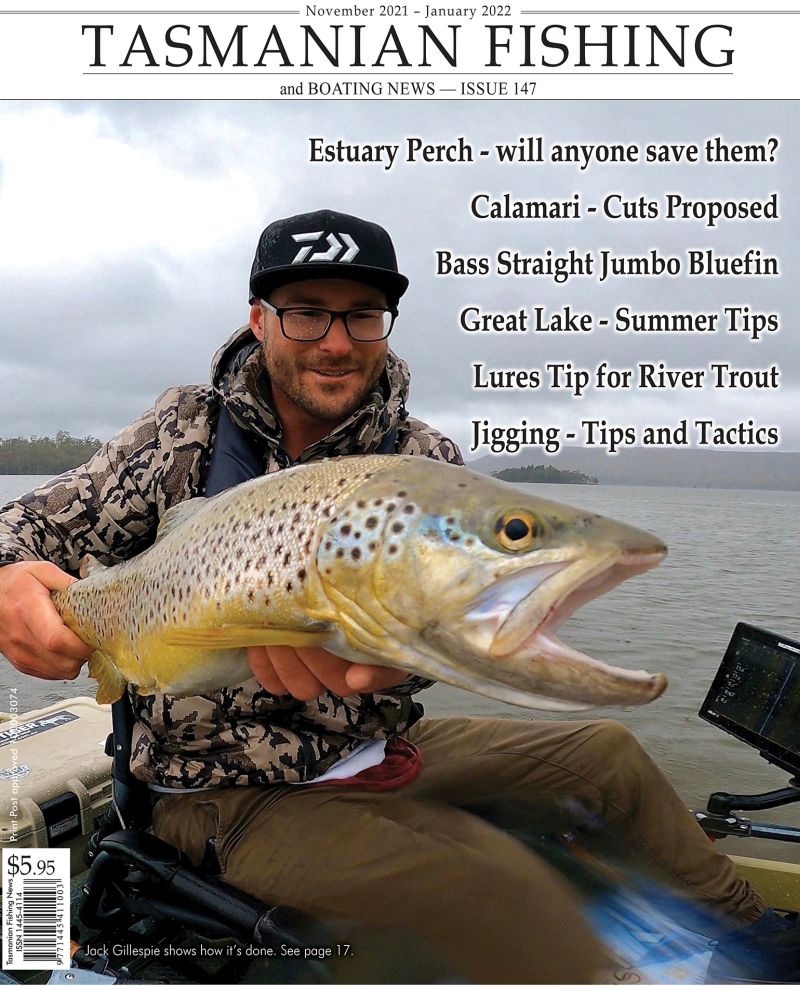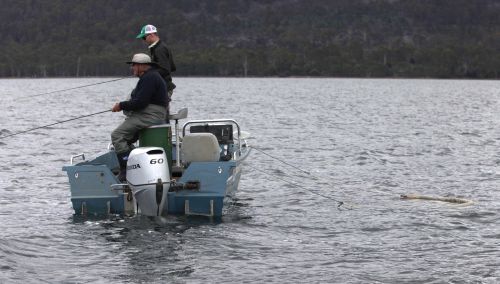Atlantic salmon the hard way
Scott McDonald
The first Atlantic salmon eggs used to begin Tasmania's Atlantic salmon aquaculture industry were introduced into Tasmania in 1984. From these humble beginnings a valuable Tasmanian industry has evolved with a worldwide reputation for having a premium disease free product. This industry provides a spin off to all anglers in the form of regular escapes of salmon from the farms.
The D'Entrecasteaux channel region contains Atlantic salmon farms over most off its length. Locals soon hear of recent escapes on the grapevine and grab all nets appear off every headland or rocky outcrop. For an angler lucky enough to be on the water within a few days of a large escape, world class fishing can be experienced. At other times though, these can be an elusive fish that exists in small numbers throughout the channel region. Most escapee salmon are captured in the gill nets within a short period of escaping.
While specifically targeting these fish can result in many fishless trips, without specifically targeting the Atlantic salmon your catch rates will be non existent. Despite this drawback, they are a fish that I greatly enjoy catching with them being an excellent fighting fish when caught on light tackle and an exceptional table fish.
My last two trips were fairly typical in the way that I target these fish. On the first of the two trips I was tossing a two inch single tail soft plastic lure using a 5wt fly rod. On this occasion I reached the shoreline I wanted to fish after around twenty minutes paddling. I had correctly anticipated that the small amount of wind present would make me drift slowly parallel to the rocky shoreline.
This shoreline was exactly what look for when targeting Atlantic salmon in the channel region with a deep drop off, good kelp cover in close to the rocks and small schools of pretty fish present along its length. After around half an hour of casting the small soft plastic lure and retrieving using small intermittent strips I was woken from my daydreams by the little 5wt suddenly coming to life and buckling under load while the drag sung its sweet music as a energetic speedster panicked upon feeling the hook.
All I could do at this stage was to keep the pressure on and let the fish run as there was no way I could muscle this fish on the 5wt. With my kayak being slowly dragged in its wake the fish headed out into deeper water. This has been my saving grace when fighting these fish on light tackle as if a fish that powerful wanted to run straight into the kelp, I would never land one on the tackle I use.
After five or so minutes of progressively shorter runs the fish was revealed to be what I had thought it was and was a nice Atlantic salmon just over two kilos. While small compared to some of the escapee salmon caught at times it was still a welcome capture. All I had to do know was to land it. I don't carry a landing net on my kayak making do with a small gaff but I thought that my best option would be to beach the now tiring fish.
With the Atlantic salmon now well under control and lying beaten on its side by the side of the kayak I changed angles on my rudder so I was now on full lock to push me with the current's assistance towards the shore. After several minutes I reached the shoreline where I beached both the kayak and the Atlantic salmon and snapped off a couple of photos of the fish.
On the second of these two trips I was out paddling in my kayak and decided that since I had thrown a rod into one of the rod holders I it wouldn't hurt to have a troll for a while. I often do this although mostly all I am rewarded with for my efforts are the dubious prizes of barracouta and small Australian salmon. On this occasion though, I thought that it may had been worth my trouble as I had taken the Atlantic salmon mentioned above only three days earlier.
I had been trolling alongside rocky shorelines for around an hour before my small overhead outfit buckled to a solid strike. Again the fish ran towards deeper water away from the weed and rocks. A see-sawing battle evolved with the fish neither taking much line but taking instantly back any line that it yielded.
By this stage, the fish was directly below the kayak but still fifteen or so feet below the surface of the water. Due to the water being discoloured from all of the recent rains, the fish still wasn't visible. Suddenly the fish took a fast but short run and then jerked a couple of times. It then took a fast and fairly long run before just becoming a light but dead weight.
Thinking what the hell is going on here, I quickly retrieve whatever was now on the end of my line. As it surfaced besides the kayak I noticed that I had just caught the front half of an Atlantic salmon which would have been around the 2 kilo mark had it been a whole fish. I immediately lowered the still bleeding salmon back in to the water in the hope that whatever had taken a piece of it would come back for the rest and allow me to see what it was. When nothing happened I threw the fish into the kayak and paddled into a nearby beach to take a photo of what was left of my salmon.
While the ending of my last trip was certainly unusual in the way it ended, how I had originally hooked the fish was using one of my most productive methods of targeting these fish. This method involves slowly trolling small bibbed minnows, metal spoons or soft plastics alongside lightly weeded rocky drop offs. If schools of pretty fish are present and there has been a recent escape of salmon you can feel reasonable confident that you may see some action.
When trolling small soft plastic lures I favor 1/16oz jig heads as this lightly weighted head ensures that the lure tracks a couple of inches below the surface. When fishing this rig I use two or three inch single tail plastics. I use single tails because these have a good action when retrieved at a constant speed. While fishing this shallow running rig I will also troll a bibbed diving minnow.
On sunny and calm days I troll a black deep diving bibbed minnow. This has proven to be a reliable colour and lure pattern for me over the years. Early or late in the day or alternatively if there is a bit of chop on the water I troll shallow running bibbed minnows in natural baitfish colorations. Small metal spoons have also produced the goods for me in the past and many successful anglers that I know swear by and use this style of lure almost exclusively.
All Atlantic salmon that I have caught and also that I have seen caught have come from within close proximity to the shoreline. When I say this I mean Atlantic salmon which have been caught in a salt water environment. Salmon in freshwater dams do not seem to do this. I have found that unless you are fishing adjacent to a fish farm, if you are more than twenty metres off shore you will not get a Atlantic salmon. Most salmon I have seen caught have been hooked within ten metres of the shore. I have found that the best way to target these fish is to use your trout lures and your trout gear.
Atlantic salmon are very similar to trout in many of their habits and trout fisherman can use these shortcuts to taste success much quicker. Small spinning rods and reels spooled with 2-4kg line are ideal. Unless casting very light lures I tend to use small overhead outfits. Again when using this style of outfit 2-4kg line is perfect and allows these sports fish to give a demonstration of their fighting prowess.
For those anglers that wish to tackle these fish on fly, a 5-6wt outfit will be more than adequate. While I have seen Atlantic salmon over 6.5kilos caught in the D'Entrecasteaux channel, the clean fighting habits of these fish allow specimens of this size to be successfully handled on trout gear. Get out there, have a go you can't catch them sitting watching T.V. in your loungeroom.
Scott McDonald



